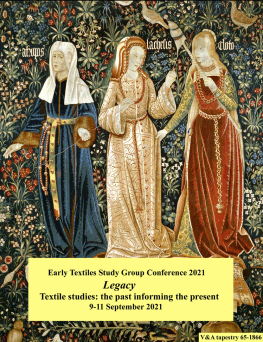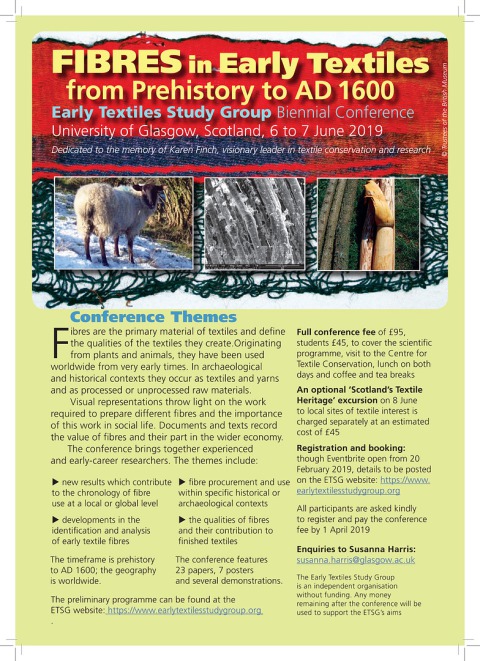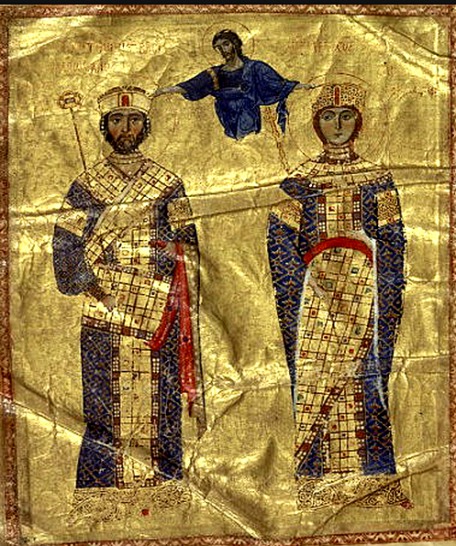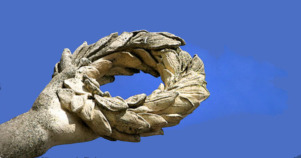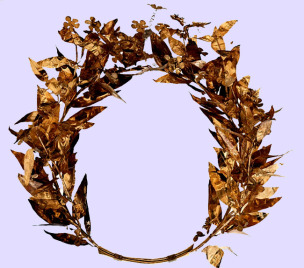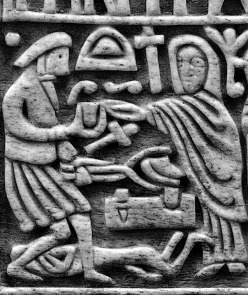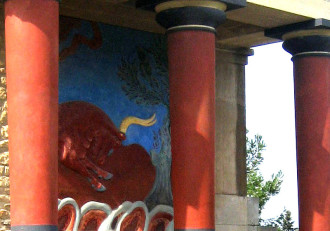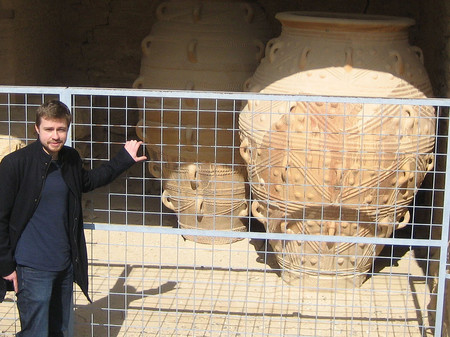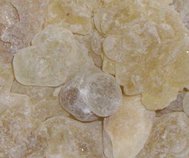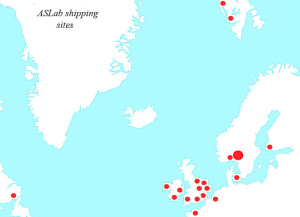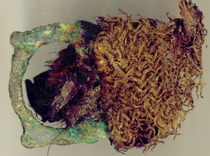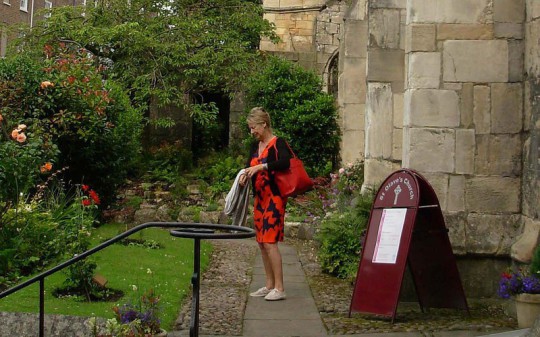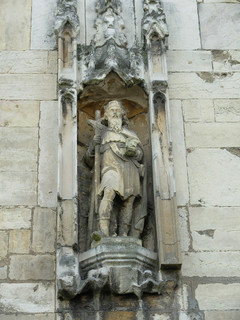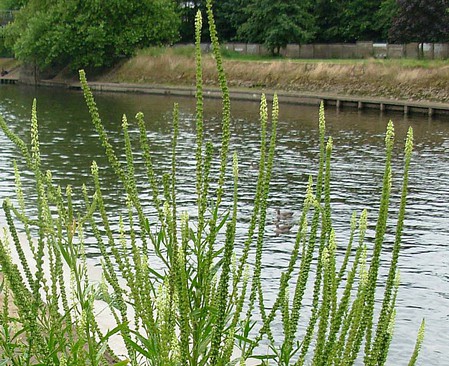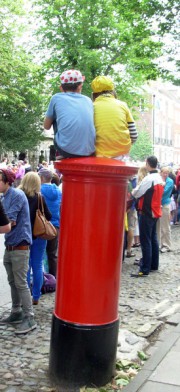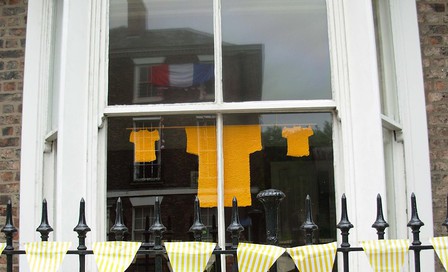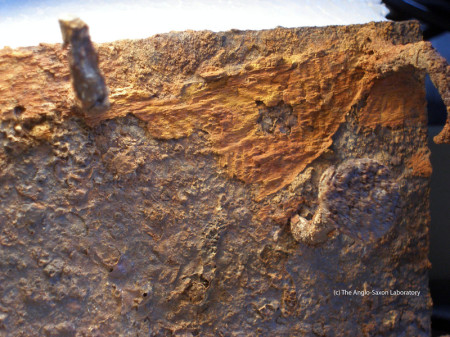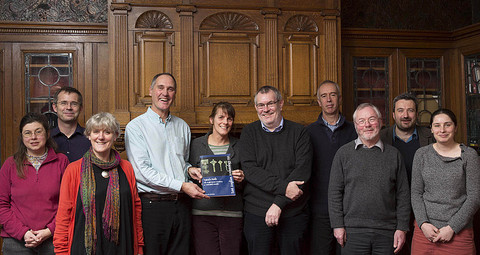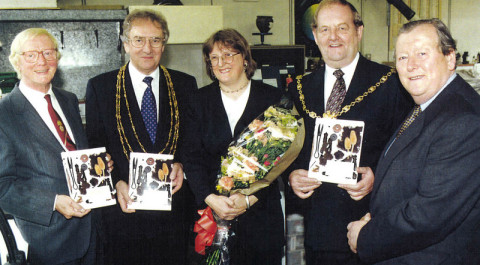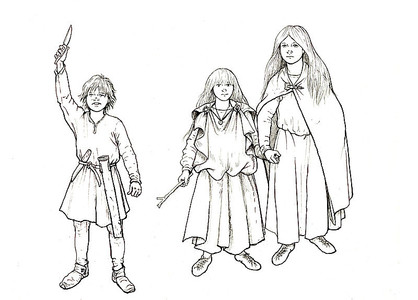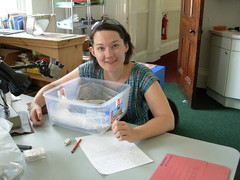The Galloway Hoard organics
For those who have written in with an enquiry about the textiles associated with the Galloway Hoard, my report is on our Pangur Press page, Galloway Hoard
Yarn bombing for Her Majesty
I've said it before, there's not much that you can't make with a pair of knitting needles and a ball of yarn.
This tribute to our late Queen was spotted on a royal mail pillar box in Bishopthorpe Road, here in York.
Photo courtesy of Nick Hilton
On the occasion of
the Queen's funeral 19 September 2022
Legacy conference, 9-11 September 2021: update
We now have a full programme of papers from divers contributors. If you would like to join us, tickets are available from Eventbrite ETSG conference tickets
and the programme and book of abstracts, compiled by the conference organiser, Cordelia Warr, can be downloaded here.
ETSG Legacy conference book of abstracts[...]
Adobe Acrobat document [867.5 KB]
Legacy conference, 9-11 September: CALL FOR PAPERS
The Early Textiles Study Group will be holding its 17th conference this year. When we were casting around for a topic, we noticed that the founder members of ETSG are now in their 60s and 70s (or even older) and yet we are still energetically pursuing careers with the same enthusiasm as before. I recalled how, many years ago, John Peter Wild had remarked that a career in textiles seemed to be a recipe for longevity, since at the time we had several grande dames in our field still active in their 80s. Many of us remember with fondness our great mentors in this older generation (mine was Elisabeth Crowfoot). At the same time, we also have a duty to think about what our own generation is leaving behind for the next.
Out of this came the theme for this year’s conference, Legacy. Cordelia Warr, Head of the Department of Art History and Cultural Practices at the University of Manchester, has agreed to convene the conference in Manchester, 9-11 September. Covid has of course disrupted the process and we shall make a final decision in late June as to whether we shall meet in-person or on-line (for updates, see the ETSG website). Meanwhile, Cordelia is inviting abstracts for papers to be sent to her by the 1st June. Topics may include, but are not limited to, pioneers in the study and reconstruction of early textiles; collections, their histories and their futures; and fresh insights gained by applying new methodologies to old collections and archives. She requests abstracts of no more than 250 words to be sent to her by email, cordelia.warr@manchester.ac.uk, along with a brief biography. A flyer can be downloaded here.
The image in our poster is of a Flemish tapestry depicting the three Fates spinning the yarn of life. On the right, the youthful Clotho holds the distaff, in the centre the more mature Lachesis draws out the yarn, while on the left, Atropos, with a sad expression on her face, lets the spindle drop to the ground. This meme of three women controlling individual human destinies through the metaphor of spinning yarn, is one that recurs elsewhere, in, for example, the Roman Parcae and the Norse Norns. Here it is depicted in a piece of textile art which has been curated for five centuries and is in itself a representation of our textile legacy. You can see the original in the Victoria and Albert Museum (Tapestries Room 94), South Kensington, which re-opens its doors to visitors on 19 May.
May 2021
Tom Srahan 1958-2020
It is with great sadness that I have to report the loss of a great friend and very dear colleague, Tom Srahan, who died suddenly at his home in September.
Born in Port Laoise, Ireland, Tom travelled around Europe in his teens before winding up in Britain. Once here, he developed a great fondness for the English (he demanded I teach him the rules of cricket in return for the basics of graphics software) and became a British citizen in 2014. Attentive readers may have noticed his name on line-drawings illustrating my research, but this was only one of his skills. He was a talented musician, skilful portrait painter and as a cartoonist he appeared in satirical magazines such as Punch under the name of TAS. We all remember his wickedly Irish sense of humour and his cartoons and birthday cards were something to look forward to. Most of all, though, his talent was for friendship. There never was such a stalwart advocate for, and supporter of, those he cared for.
BFF, Tom, BFF.
October 2020
Conference on Fibres in June 2019
All about the Royals: a conference on 'Precious Cloth and Court Culture'
The Early Textiles Study Group will be holding its 15th conference in September 2017 (weekend of 16th and 17th) at Lucy Cavendish College, Cambridge, on the theme of Precious Cloth and Court Culture. A range of speakers have been gathered together by the conference convener, Dr Anna Muthesius, and together they will examine dress at the courts of medieval Castile, Byzantium, China, Java and the Ottoman Empire. English courts of the 7th to the 16th centuries are represented by four speakers. Stand by for plenty of images of sumptuous silks and cloth of gold, as well as scholarly research.
If you want to come, you will need to get your bookings in promptly, as the closing date is 31st August. The booking form can be found at Lucy Cavendish website
Any queries can be emailed to Anna Muthesius ( amm10@cam.ac.uk ) and you can download the programme here:
Adobe Acrobat document [365.8 KB]
The image, above, depicts the Byzantine emperor and empress-consort and comes from Homélies de Jean Chrysostome MS Bibliothèque Nationale de France, Manuscript Coislin 79, folio 2 bis verso. (In Public Domain).
30 July 2017
Put a cap on it
Picking up where we left off (Power Dressing in the Bronze Age, below), I see that the woman’s cap has excited some interest. In response to popular request, here are further details. The cap was made for us by Mary Charlton, at the time a theatrical head of costume, although now a lecturer at Nottingham Trent University. It was a copy of one from a Bronze Age burial at Borum Eshøj, Denmark, which was published in H.C. Broholm and M. Hald’s magnificent volume, Costumes of the Bronze Age in Denmark (Copenhagen, 1940), pp64-77. The woman who wore it was about 60 years old when she died and was buried in a log coffin within the Eshøj mound.
Name and acclaim
It seems that some of you thought I ought to name and shame the people mentioned in the last entry (Weland’s way). This troubled me because my aim was to draw attention to the systemic nature of prejudice and the ways in which it can affect someone's life. Naming of individuals was never on the agenda.
Henrica Annaert, Flemish Heritage Agency, Brussels. One of life's good companions, Rica has twice escorted crates of artefacts to York (her travels including an impromptu seminar for customs officials) and has enabled my contributions to conferences.
Dr Ciara Clarke, Director of AOC Archaeology. When faced with a Viking hoard which could not leave Scotland, Ciara came to me for ideas. With the help of her extremely able conservation team (led by Gretel Evans), we developed a procedure that meant that neither the hoard nor the consultant had to be moved.
Professor Søren Sindbæk, who carried my virtual presence around on a Skype-connected laptop at the CNVT seminars, while chanting ‘With ‘er ‘ead tucked underneath ‘er arm’ (I heard you Søren!).
The Metalwork Conservation team at The British Museum, who have expertly packed up artefacts from three Anglo-Saxon cemeteries for transport to York.
Professors Marie-Louise Nosch, Eva Andersson Strand and Jane Malcolm-Davies at the University of Copenhagen and Professor Laurent Verslype in Belgium, for supporting and facilitating lectures in their institutions; Dr Isabella von Holstein, Barb Klessig and Dr Margarita Gleba for including me in roundtables and seminars; and Professor Matthew Collins for involving me in a whole load of other stuff!
My textile ‘family’, especially Hero Granger-Taylor, Dr John Peter Wild and Frances Pritchard.
The INCLUDE network at the University of York for their ideas and inspiration.
Herbert Smith Freehills for changing their business culture from wary acceptance to positive encouragement.
Finally to all those who have worked in my immediate vicinity at ASLab, especially Isabella von Holstein, Matthew Thompson and Greta Pepper, who, with energy and good humour, have streamlined the whole process.
I can see now why Oscar speeches take so long.
Interesting fact: not all laurel wreaths were laurel. The gold stephanoi (crowns or wreaths) recovered from Macedonian tombs were made to represent myrtle, olive, ivy and oak, as well as laurel. Others have been recorded from Crete, Cyprus and Egypt. This myrtle wreath is in the Museum of Fine Arts, Houston, and is dated to the 4th-3rd Century BCE. More can be found in the Archaeological Museum of Thessaloniki
Having talked myself into a better humour, I shall now turn to reviewing the last twelve months at ASLab. Stand by for a blog catch-up over the next few weeks.
Weland's Way
I reckon you have to be in an upbeat mood to write a blog and the year-long silence in this quarter has been due to a series of rather disheartening events. My feathers have been drooping to say the least. The cause? Well, there have always been a few academics who think that disabled people should not be allowed to prosper but, sadly, these views seem to be gaining traction in the archaeological profession. In the last year alone, The Anglo-Saxon Laboratory has been axed from two major projects, for no reason other than that I, as the business owner, am disabled.
What? You did not know that I was disabled? Why would you – it is entirely irrelevant. It must be obvious from our record of successful project management and my personal bibliography (in the last two years consistently ranked in the top 0.5%-5% on Academia), that it does not matter a jot.
Even so, I can cite the case of a university Disability Officer who thinks that the disabled should not be allowed to attend conferences by electronic means, still less give lectures. Then there are the archaeological institutions that appear to advise staff, not on how to integrate disabled people, but on how not to get caught for discrimination. And who would stoop so low as the post-doc at a London university, who cites my disability in her funding applications as a reason for her to be appointed?
It is enough to make even the most resolutely optimistic feel a tad dejected.
However, those of us who think that myths and legends have something significant to say on the human condition can take heart from the story of Weland. Like the Greek Hephaistos, Weland was a lame god (note the crooked leg in the picture). He was a famously skilful smith, imprisoned on an island without access to the outside world and forced to work for his captors. He eventually made his escape by using his skills to construct wings. Moral: for the creative mind there is always a solution, it just needs to be found. True, Weland did murder his enemies before he left - though that's perhaps not a smart career move for an archaeological project manager and artefact researcher.
Power dressing in the Bronze Age
Since we were speaking of the Bronze Age, I am reminded of a costume we made some years ago, when I was working on an EBA burial in Yorkshire. In that instance, the organic remains were limited to a fragment of animal hide, but the body had been buried with a considerable array of metal and jet accessories and the subject of how they would have been worn naturally came up. The bronze tubes, jet beads and conical ‘buttons’ were well-known artefacts in Britain, but there were at the time academic texts stating that the cones must have been stitched to garments, because they would rotate out of position if threaded on a necklace cord; followed by a contrary argument that it would be impossible to thread a yarn through them, because of the V-shape of the bored holes. I pointed out that to an experienced necklace-maker, especially one with knowledge of Danish Bronze Age costumes, neither of these issues would present a problem. This was summarily rejected.
Well, as Maya Angelou once said, ‘If you want me to do something, tell me that I can’t’. I set about proving my point.
The accessories were replicated in modern materials (clay replacing jet and brass-encased wooden tubing for the bronze). The problem of threading the yarn through the V-shaped holes was easily resolved. I used the waxed twine that weavers employ for heddles and found that it nosed its way through the narrow V-shaped hole without any difficulty, and without the need of a needle. I next tied the twine to a softer wool yarn and pulled that through. I then mounted the cones, beads and tubes on a framework of leather thongs, using simple knotting techniques. It was so easy, it was hard to understand what the fuss had been about.
To complete the costume, we had a sleeved brown wool top and a cap made for us by expert costume-maker, Mary Charlton. Both were copied from the Danish Bronze Age finds. The cap, worked in sprang technique in wool yarn, proved to be a particularly elegant and adaptable garment and, with the right hair-style, it emulated head-coverings depicted on Greek Bronze Age vases. Here, the ensemble is modelled by a post-grad from the University of York, Chloe Brown.
The only disappointment was the discovery that there had been far more tubes, jet beads and cones from the Ingleby Barwick burial (which originally inspired the replica) than we had realised. A more accurate reconstruction of that particular find would probably have been a full shoulder-cape covering front and back of the upper body. And that is surely what Alison Sheridan would call ‘power dressing in the Bronze Age’.
24 January 2016
Fire and flood
Must Farm, Cambridgeshire, has also hit the headlines recently, following the renewed excavations there by the Cambridge unit on the site of a palisaded Bronze Age settlement. The buildings had been burned down in the settlement's final stage - either deliberately or by accident. The combination of the charring of the textiles, followed by preservation in a waterlogged environment, has led to an unprecedented survival of a range of different textile types. For more details and pictures, see our special web page Must Farm
12 January 2016
Leave your snorkel at the door
York has been the first item on the UK news between Christmas and New Year, due to heavy flooding in the city. My thanks to all those who have emailed to ask how we are – good to know we are in your thoughts. I can report that both the office and our storage facility are well above any potential flood zone. My home, on the other hand, was almost a different story. We were on red alert for much of Christmas and I was rousted out of bed by the army in the small hours of the 27th. Being a phlegmatic soul, I thanked them, registered my surprise that our evacuation centre was apparently a school on the opposite side of the river (if you think I am getting in a helicopter, forget it) and then went back to bed. The river peaked 0.2 metres below the top of our local flood barrier.
For those interested in landscape archaeology, there is nothing new about flooding in York. The earliest part of the town was built on a terminal moraine that crosses the River Ouse at its confluence with the Foss. The Ouse itself has a massive catchment area that covers much of the Dales and Moors of North and East Yorkshire. Such is the length of the river system that rain in the upper Dales can cause levels to rise in York 24 hours later. Since the Ouse is tidal up to just below York (and into York itself when Naburn lock is breached), at high tide floodwater cannot exit and backs up into the city centre.
Early settlement was on the high ground of the moraine, leaving the riverside to quays and water meadows. As the city grew and flourished economically, however, buildings were sited in increasingly hazardous zones. The government and city council have spent millions on flood defences, but when one element fails (in this instance a pumping station on the Foss), in it all comes.
A vote of thanks to the army and emergency services, who have been doing a great job in difficult circumstances.
31 December 2015
A Royal Visitor
The craft that tie up on our stretch of the river change with the seasons and right now it is the time for narrow boats. Some of them look as if they have floated out of an H E Bates novel, with crooked metal chimneys, bicycles on board, usually a pet dog and quite often a garden on the roof. This more decorous vessel caught my interest because of the name. I was clicking away with my camera when the owners emerged. My thanks to Barbara and John - visiting from Dorset – for telling me about their boat, their travels and their enthusiasm for Anglo-Saxon Wessex.
There were several famous Æthelburhs but this one was the wife of King Ine, who lived circa 673-740. She was co-ruler with Ine and, like Æthelflæd, Lady of the Mercians (two centuries later), she seems to have been a military campaigner in her own right. She is also known to have travelled to Rome with her husband after his abdication – a mighty undertaking in the 8th century. I like the fact that her vessel was moored at what was to become the smart upriver end of the Anglo-Scandinavian town, at the landing stage for St Mary’s abbey and a stone’s throw from the supposed site of the earl’s palace.
What the ...?
The ASLab office is only two minutes’ walk from the Museum Gardens – which is the perfect place to take your lunch and clear your head after a morning’s work. Over the years I have watched it change from boring civic planting schemes to the beautifully landscaped gardens that you will find today. York Museums Trust has been responsible for some new introductions, such as Storytelling Corner (a copse of yew and holly enclosing upturned stone sarcophagi as seats), a sundial embedded in the lawn, where you can act as your own gnomon, and every now and then a temporary piece of outdoor artwork.
This one did make me laugh. Here is a tree, for no apparent reason, wrapped up in knitting and crochet and inhabited by charmingly incongruous plants and animals. Can anybody out there tell me who did it and what it is about? As someone with an eye for the textile crafts, I’d like to know more: email pwr@aslab.co.uk
Our man in Crete
Knossos. There's a name to conjure with. Home of the Minotaur, bull-leapers, bare-breasted snake goddesses, Ariadne with her clew of thread, Daedalus escaping with Icarus, double-headed labrys axes and Linear A and B tablets.
Famously excavated and reconstructed by Sir Arthur Evans, the place is an intoxicating mix of myth, legend and archaeological reality. You can imagine, then, the excitement round here when our own Matt Thompson (see below, Labours of Hercules), won a three-month internship, funded by the British School at Athens, on the Knossos Curatorial Project.
Matt tells me that on his arrival in Crete, he was met with snow and earth tremors (Poseidon Earth-Shaker saying hello, I guess), but now the sun has come out and he has settled down to the task in hand, of cataloguing coins and pottery. He has also spotted shelves full of loomweights – which must make him feel at home. The Stratigraphic Museum where he is based is at the site of the Minoan palace, which means he can roam around looking at pots big enough to hide forty thieves and some garishly reconstructed wall paintings, including red bulls and a blue monkey.
If you would like to know more about this extraordinary site, click on this link for a series of lectures entitled, Knossos: from Labyrinth to Laboratory.
6 March 2015
Michael L Ryder
It is sad to report that the author of one of my favourite books, Sheep and Man (yes, really, all 846 pages of it), died on 6 February, aged 87. I first met Michael in about 1980, when I had just begun to take an interest in textiles. I was looking at the different methods of characterising wool and was keen to adopt his ‘fleece-type’ methodology into my own work. With typical thoroughness, he provided standard samples of fleece so that he could test the accuracy of my work (and my microscope), after which we were able to compare results. That was the start of what was for me a highly productive correspondence that lasted to the end of his life. In his 80s he remained rational and well-organised, though I should have guessed that something was wrong when his final Christmas card – for the first time ever – did not include a picture of a sheep.
Michael will be much missed round here, for his clarity of thought, intellectual energy and most of all his dedication to ‘getting it right’. You will find a copy of his enormous bibliography on our website at Ryder bibliography
15 February 2015
An obituary has been added to Michael's bibliography page.
24 January 2016
Reports of my death...
...are somewhat exaggerated. To those people who have been contacting our office over Christmas, including one apparently compiling my obituary, I can confidently state that, as at 29 December 2014, Penelope Walton Rogers is alive and kicking!
The rumours have been tracked back to a paper published in the Journal of Archaeological Science (53, 2015, 297-303, on-line in November 2014) by a team from the University of Copenhagen. In it, the authors consistently attribute the identification of four animal fibre specimens by microscopy to ‘Rogers, PW, 1998’ and then state (p302) that ‘the original analyst is deceased‘. It is hardly surprising that a lot of people thought that meant me. Had the full report title been given in the paper’s references (see our own Bibliography for 1998), the reader would have seen that the analyst was in reality H M (Harry) Appleyard – who is indeed no longer with us.
This is not the only source of consternation in this paper. For a preliminary response to its content, see Response.
I try very hard to avoid embarrassing our clients in public, but you know, Copenhagen, you really ought to have checked with us before launching into print.
On the other hand, I think I would have quite liked to have read that obituary.
29 December 2014
Perfumes of Araby
A hint of glamour has wafted into our lives in recent years. Rhea Brettell at the University of Bradford has involved us in an extraordinary study of the resins used to perfume burials of the Roman period. You may well wonder how perfume can be detected after almost two millennia in a grave, and yet this ground-breaking project, carried out in Bradford’s Department of Archaeological Sciences (Professor Carl Heron) has done just that (for an abstract, go to our Bibliography page). The aromatic resins exuded by certain trees have been successfully identified in graves in Britain, using GC-MS, as products of (i) the pine family, Pinaceae, (ii) a species of Mediterranean Pistacia and (iii) a species of Boswellia. This last is the gum-resin commonly known as frankincense, imported from Arabia or even further afield.
The exudates were most commonly detected in graves with other indications of elite status. This adds to the list of status symbols reviewed by J P Wild in ‘Luxury? The North-West end of the silk-purple-and-gold horizon’, 169-179 in C Alfaro Giner, J Ortiz Barcia and M J Martinez Garcia (eds), Luxury and Dress. Political Power and Appearance in the Roman Empire and its Provinces. Valencia: University of Valencia (2013). Early in 2015, Dr Wild will be making available one of his unpublished reports on a burial containing gold thread, as a free download from our Pangur Presspage.
We have the gold, we have the frankincense. Any offers for myrrh?
Happy Christmas from all of us at ASLab!
24 December 2014
Call me Ishmael
I have just emerged from my fortieth shipwreck. Well… what I really mean is that we have just finished crating up the latest batch of material from a ship museum. Now that I have divested myself of face mask and overalls, wiped the debris off the microscopes and scrubbed away the black tar ingrained in bench-tops and fingernails, it is possible to look back with some satisfaction on a long line of similar projects.
The fibre products recovered from shipwrecks (and parts of ships re-used in harbour walls and quaysides) are something our laboratory has been investigating since the early 1980s. They include caulkage, cordage, basketry, mats and sailcloth. Their study represents one of the most gruelling tasks that we take on, although it is also one of the most rewarding.
Take ropes, for example. Everyone expects them to be made of hemp, and yet that is one of the least common fibres to be identified. Plied palm fibre appears on the medieval English south coast, plaited goat hair in Norway and those ports that traded with Nordic countries, while coir (coconut fibre) is surprisingly common in northern waters, especially during the period of the East India trade. Juniper, tree bast, hair moss and whole flax stems have also been identified. The ropes carry with them part of the history of the ship. At Newport in South Wales, for example, a ship likely to be Iberian in origin seems to have arrived rigged with hemp (for once), but the hawsers used to hold the vessel in place were made of grass.
Caulkage – fibrous materials dipped in tar and used to line seams and repair patches – also has regional and temporal patterns, although these can only be discerned if the structure of the vessel and the function of the caulkage are first considered. (The mistake the inexperienced analyst often makes is to jumble together the different types.) For example, the fibre rolls that run along the horizontal overlap between planks steadily changed from wool to hair during the course of the medieval period. They are plied in Norwegian vessels and single-twist in English ones. Both give way to non-twisted plant fibres on the introduction of carvel construction. The scarf joint, on the other hand, where the ends of planks overlap, are lined with a thin fabric, true felt in countries with a commercial felt industry and felted textiles where there was none. Other textiles could be used along the keel and as seating for masts and spars.
Wooden repair patches could be neatly made and padded with tufts of fibre, though others appear to have been wadded with anything that came to hand. One can only imagine what dire circumstances induced someone to stuff a fur-lined boot into the gap in one particular boat from Oslo harbour. As I always say, every site has a story to tell.
5 December 2014
Some useful links
For more on the boats from the Barcode site in Oslo click on Barcode
For a seaworthy replica of one of the Barcode boats, see NMM boat blog.
For the Vaterland I boat, including our caulkage report, go to Vaterland
For the Newport ship fibre products click on Newport reports and scroll down to 'Caulkage' and 'Textiles, cordage, basketry'.
'Dyes of the Viking Age' download
A clearer copy of the 1988 paper, 'Dyes of the Viking Age' has been made available on our Pangur Press web page. If you downloaded this before 9 November 2014, you may want to revisit the page. Our apologies for the poor quality of the previous version (due to thin paper and ghosting from the reverse side) and our thanks to those who took the trouble to write in and tell us about it.
13 November 2014
On being an Old Crone
It was my birthday a few days ago. I am 64 and I find it hard to understand those people who simper over their age. What’s to be ashamed of?
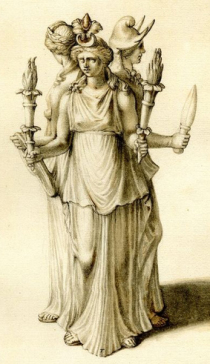 Three-bodied Hekate, goddess of the phases of the moon, the cycles of light and dark, transitions and crossroads. The British Museum.
Three-bodied Hekate, goddess of the phases of the moon, the cycles of light and dark, transitions and crossroads. The British Museum.
Within the women’s movement, the phases of a woman’s life are often defined as maiden, mother, crone – and many of us have discovered that the third stage suits us very well. Besides, if you belong to the post-war baby boom, it only represents another invitation to re-write the script. I already have older female friends who are approaching their advancing years with indecorous laughter and a lively sense of adventure. If you hear old crones cackling, there is probably a good reason for it.
To those unguarded fools who have asked if I am considering retirement, my reactions have been variously indignant, ‘I’m good for another twenty years – thank you’, puzzled, ‘ But I ‘m only just getting my second breath’, or defiant, ‘They’ll have to beat me off with a stick’.
If an archaeologist cannot appreciate old age, who can?
Plaid and sporran?
It came as a great relief when the Scots voted to remain in the union on 18 September. Our company commissions analytical work from several Scottish institutions and some of our favourite clients lie north of the border.
Right on cue, along came a uniquely Scottish find, from a site in the heart of the capital city. Excavated in the New Waverley development in Edinburgh, by AOC Archaeology, the object was found on the left hip of an adult male buried in the 16th or 17th century. It is a lightweight metal buckle embedded in a complex of organic materials – hence its trip to York, where we have special skills in this form of analysis.
On investigation, there proved to be four different materials present. Threaded through the buckle was a narrow leather strap, much worn and seemingly repaired. In and around the buckle and strap was a layer of calf-hide with hair intact, the hair facing outwards. Behind the buckle were loose folds of wool textile. On the back of the textile was tissue from the body itself.
The small size of the buckle, its position on the body and the form of wear on the strap suggest a purse. Interestingly, early sporrans were described as purses suspended from the belt and made of calfskin or deerskin. The twill weave and smooth yarn of the textile are directly comparable with other Scottish textiles of this period, especially those which are checked or striped – although no pattern could be discerned in the small piece that has survived here.
We shall have to wait for specialists in Scottish dress to provide an opinion, but for the time being we like to call this our ‘plaid-and-sporran’ burial.
Caught on camera
Cassandra Clark, author of the Hildegard of Meaux mysteries, here pondering her next plot in the garden of St Olave’s Church. Cassandra and I have been firm friends since we met in the 1970s and this was snapped after we had been to a concert in Bootham's beautiful parish church.
The church would have looked rather different when Hildegard’s fictional feet were treading the paths of York, as its present appearance owes much to a 15th-century re-build. However, it was certainly there in the 14th century, as a small Anglo-Saxon church, adopted into the precinct of St Mary’s Abbey. Founded by Earl Siward, a Scandinavian who married into the Northumbrian royal house, it was dedicated to St Olaf (anglicised to Olave) – he who converted Norway to Christianity at the point of a sword. The abbey, of which it became a part, is still represented by the high precinct walls that run the length of Marygate, the gatehouse, the hospitium, the King’s Manor (now home to York University’s archaeology department) and some picturesque ruins in the Museum Gardens. The architectural splendour of the abbey, which some claim vied with the Minster, would have been a familiar sight to our Hildegard.
If you like your medieval sleuths as strong-minded women, try The Law of Angels, set in 14th-century York, against the backdrop of the gild-workers' mystery plays.
Fellowship
Sometimes, large institutions can surprise you with their flexibility. I am pleased to announce that for the next three years I shall have the title Honorary Visiting Fellow at the University of York Archaeology Department. At one stage, the appointment almost ran aground in the shoals of university bureaucracy, but the Head of Department, Chair of the Board of Studies and the Registrar put their heads together and, with the approval of the Vice-Chancellor, found a way to navigate a passage through. I believe that’s called ‘joined-up management’. My thanks go to all concerned and especially to Professor Emeritus Martin Carver for the nomination and to Dr Sam Lucy at the University of Cambridge and Dr Barry Ager at The British Museum for supporting it.
Whilst I am fully appreciative of the honour, to an egalitarian soul like me, it is not so much the title that matters as the opportunity it brings for collaborative work with a thriving archaeology department. As well as solid early medieval research carried out within the department itself, there are connections with the scientists in BioArCh – with whom our company already has links – and also the internationally famous Centre for Medieval Studies. For more about these organisations, see the links below.
2 August 2014
http://www.york.ac.uk/archaeology/
http://www.york.ac.uk/palaeo/facilities/bioarch/
http://www.york.ac.uk/medieval-studies/
Apocalypse - whenever
I have an agreement with an environmentalist friend of mine that, should the economy collapse and we all end up living in wigwams, she will do the food and I will do the clothing. To clothing you can add baskets, hammocks, nets, wickerwork, and anything else that can be knotted, knitted, twined or felted. It began as a joke, but it is an intriguing thought: how would you subsist in a post-apocalypse world - assuming you were not killed off by gangs of marauders? With an eye to my potential responsibilities, I have been keeping a watch on what is available locally.
There are in this area several stands of lime trees, a good Neolithic source of textile fibre. Common stinging nettles can also be used for a soft fine fibre, provided that Jane has not taken them all for the pot. Given the number of parks, bowling greens and grass verges in Bootham, a small flock of sheep (for milk as well as wool) could be a manageable addition. Willow already grows on the local water meadows (or ‘ings’ as they are called round here). Flax might be a problem in this area of low rainfall, but quick-growing hemp could be sown after the broad beans have finished. Then there are tree galls, a useful source of black dye (and also ink, since we expect to be writing messages to each other on bark). If you think that you might not be overly concerned about the colour of your clothing during a fight for survival, then it is worth considering the archaeological evidence that colour was an immensely important matter for early societies, marking cultural and social divisions and acquiring ritual, even magical, significance.
Finally, the common wayside plant shown here was spotted last week on the riverbank, shooting up from among the tansies, wild cranesbill and meadow bindweed (all credit to York City Council and the water authorities for the ecologically-friendly way that the river banks are maintained). This is the medieval dyeplant variously known as weld, dyer's rocket, dyer’s mignonette or yellow weed, botanically, Reseda luteola L. The whole plant – roots, stems, leaves and flower-spikes – can be chopped and put into the dye bath. For a good, clear, wash-fast yellow, the wool has to be prepared in a bath of mineral alum, which can be obtained on the Yorkshire coast near Whitby. Failing that, a range of shades from golden brown to olive-yellow can be produced with other pre-treatments. Add some roots of wild bedstraw and you have a rich rusty orange. Dip the yellow wool in a woad vat and out comes Lincoln green.
Personally, I hope the western economy survives intact, since I am getting rather old for life in a wigwam, but if it does all go belly-up, you know where to come.
23 July 2014
Allez, allez, allez!
It has nothing to do with archaeology, but the second stage of Le Grand Depart (the Tour de France before it gets to France) came past our office on Sunday. Our colleagues in Alliance Francaise broke out their Tricolore and red polka dots, tee-shirt-shaped flags and spray-painted yellow bicycles popped up all the way along Bootham. I’d like to show you pictures of the cyclists as they went past, but all I caught was one blurred helmet and a forest of arms holding cameras. Instead, here are snaps of the spectators and – joy to my heart – knitted yellow bunting in the house opposite. There isn’t much you can’t make with a pair of needles. And that led us back into textiles, even if not archaeology.
7 July 2014
Labours of Hercules
Matt Thompson, having an MA in ancient history and a passion for mythology, will be familiar with the concept of The Augean Stables and The Cleaning thereof. Even the mighty Hercules, however, might have been daunted by the tasks Matt has taken on since he started work here two years ago. On top of the usual office clerical business, such as keeping the accounts up to date and helping with the website, he was tasked with building a database of our extensive library of books. He romped through that and so we added the boxes of photocopied articles. Job done. Then the scanning of four decades of my own pencil notes from publications. Yep, sorted.
He does all this with a smile on his face and the same level of enthusiasm that he brings to everything he does. Of course, his real interest is the ancient world and there is not a day goes by that I do not have some new snippet concerning Macedonian wreaths, Akkadian script, Spartan war rituals, and as for Alexander’s tomb (is it or isn’t it?) – well, that is a major source of excitement. He has more laddish interests besides and is currently spending his holiday kicking a ball around Estonia with a football side from England (let’s hope they do better than our national team).
In the manner of Hera, I keep thinking up still more enormous tasks and he has now been set to scan our immense archive of records from 34 years’ consultancy work. That should keep him quiet for a while. Maybe.
20 June 2014
Pangur Who?
The arrival of our new enterprise, Pangur Press, seems to have sparked a lively debate over the origin of the title. I assure you, I was completely unaware that there was a Disney character of that name! The one I was thinking of is the subject of the 9th-century Irish poem Pangur Bán (White Pangur). The text of the poem is to be found in the Reichenau Primer, now in St Paul’s Abbey, Lavanttal, Austria. In it the poet describes how a scholar hunts down meaning in the way that his cat, Pangur, hunts down mice. Pangur, by the way, means ‘one who fulls cloth’ and I imagine refers to the manner in which young cats tread their feet, like a fuller treading cloth (though I see that others relate it to the white of fullers earth). Anyway, I liked the name, I like cats and it is early medieval with allusions to writing, scholarly endeavour and, indirectly, textile crafts. Tailor-made, really.
For the text of Pangur Bán and translations, including one by Seamus Heaney, go to http://homepages.wmich.edu/~cooneys/poems/pangur.oldirish.html
http://homepages.wmich.edu/~cooneys/poems/pangur.ban.html
http://www.cstone.net/~poems/panguhea.htm
2 June 2014
Work hard and leave a good-looking corpus
Back in 2000, while preparing to shift the business from Textile Research to The Anglo-Saxon Laboratory, we did an audit of the reports that had been written since setting up the first business in 1980. It came as a shock, even to me, to find that only ten percent had actually seen the light of day. Well over a thousand reports, each commissioned as part of a funded research programme, were still awaiting publication.
Out of this came the idea for Pangur Press. This is a new enterprise which will aim to bring to you both unpublished reports and out-of-print publications. It is going to take some time to acquire permission from those clients who originally commissioned the work and to prepare the material for publication – and since we have no funding for it, the tasks will have to be fitted around our contract work. This is therefore being viewed as a long-term undertaking.
In order to get the ball rolling, however, we have made some of our out-of-print publications available as free web downloads. You can find them at Pangur Press.
24 May 2014
From a different angle
Evidently it pays to have a microscope set up for viewing textiles. While the iron fittings from a late 7th-century bed burial were being examined in our lab, the horizontal light that we use to look for weave structures hidden in corrosion products picked up, not textile, but the grooves and ridges of carved wood. When the light beam was moved to vertical, the pattern disappeared back into the wood grain.
Searching through the rest of the ironwork, more examples emerged, all on fittings from the head end of the grave. Steve Allen at York Archaeological Trust had already identified the wood as ash and had found that in some instances the iron fittings had been laid against flat planks and in others against the end grain of the timber. By combining his work with our own, it was possible to show that the carving was on the back of the bed head. That seems odd to modern eyes, but in fact there is a complete beech-wood bed of similar date from Lauchheim (coincidentally, ASLab is also doing consultancy work on this major group of sites) in southern Germany, where the back of the bed head has been carved and painted. The intention must have been for this to be viewed as a free-standing piece of furniture – not jammed against the wall as modern beds often are.
This is only one of a number of intriguing finds to have emerged from a small burial plot at Trumpington, Cambridge. The site is being brought to publication for the Cambridge Archaeological Unit by Sam Lucy, sjl18@cam.ac.uk.
30 April 2014
'Mr DeMille, I am ready for my close-up'
Have I not always said that Anglo-Saxon cemeteries would provide a rich vein for historical novelists, should any of them choose to mine it? It turns out that the new Tittleshall volume has been read by a playwright and media executive, who has given it five stars on Amazon. According to the internet, Adrian Drew is a member of BAFTA, a writer, producer and director and has written several plays about characters from the more recent past. Could we be seeing a Tittleshall family saga in development? Many thanks for the stars, Mr Drew, though if this goes to Hollywood, do remember that I have retained the cuddly toy rights.
10 April 2014
In Brussels
There was a long phase during which archaeologists appeared to distance themselves from the historical sources. For archaeology to become established as an independent discipline, it was necessary for its practitioners to develop their own methods, strategies and principles, without being influenced by the expectations placed on them by textual evidence.
Laurent Verslype, professor at the University of Louvain and director of the Belgian National Centre for Archaeological Research, has
obviously decided that the time is right to bring history and archaeology back together again. He and his colleagues have introduced a series of conferences entitled Translatio,
which address individual themes with both disciplines. The first meeting was held on 7 March in the Musées Royaux d’Art et d’Histoire auditorium, in the glorious Parc du Cinquantenaire in Brussels.
It focused on the subject of early medieval clothing, with historians speaking in the
morning and archaeologists in the afternoon. It proved to be an immensely satisfying meeting to attend (though in my case, of course, via Skype). Further thematic meetings in a similar vein
are planned for the future.
My own lecture was on the two protocols I first began to outline in Cloth and Clothing in Early Anglo-Saxon England, for the analysis of textile crafts in occupation sites on the one hand and costume in clothed-and-furnished burials on the other. Since publication in 2007, I have formalised these protocols into two sets of practical procedures. They have in turn become a major element within our current research strand, which is how women's lives can be reconstructed from the archaeological record. It was very heartening to discover that the patterns emerging from this study find parallels in new post-graduate research into gender in Carolingian documents.
14 March 2014
Milestones
It was an unexpected pleasure to see the members of the East Anglian Archaeology board, beaming out at me from the pages of SALON number 313. At the centre of the group is the excellent Jenny Glazebrook, clutching a copy of our very own Tittleshall cemetery report. You might think I would have noticed, but between the rush of final page proofs and the run-up to Christmas, I entirely missed the fact that EAA had reached its 150th volume with the Tittleshall publication (Bibliography).
This reminded me of 1997, when I was somewhat embarrassed to find that, despite the many worthy volumes written in-house at York Archaeological Trust, my own book on textile production at Coppergate turned out to be the 50th fascicule in the series The Archaeology of York. It therefore fell to me – though an outsider - to present the volume to the Lord Mayor. Nevertheless, it provided an opportunity to say a few words on how important these publication series are to those of us who work as consultants.
These regional series (though EAA now covers five counties) allow those of us who are jobbing archaeologists to take a break from writing small reports and to explore in depth particular collections or individual sites. We can become expansive on subjects that are important to us and address significant themes in a way that is not possible in the everyday run of report-writing.
We heartily congratulate the EAA team on reaching this milestone. Long may they, and YAT, continue with the high standard of editing and production that they have maintained so far.
16 February 2014
Tittleshall: a family and its burial plot
Dame Antonia Fraser once said that a good biographer always falls in love with her subject. Much the same can be said of Anglo-Saxon cemeteries, where writing a report on the excavation tends to turn into a biography of a community. It would be hard not to fall for the characters in the Tittleshall cemetery - probably the dead from several generations of a small family farm (the name translates as ‘Tyttel’s nook’). In this burial plot, perched on the edge of the uplands in west-central Norfolk, we found a woman dressed in layers of cashmere and fur, with a heavy gilt brooch, necklace and pendant; a man of mature years laid to rest with a bucket by his feet and his head resting on a shield of his father’s or grandfather’s generation; a young boy wearing some of the finest linen in the county, with a sword scabbard and the remains of two knives at his waist; and two little girls, the elder buried with a hybrid brooch amalgamating elements from communities to the east and west of Tittleshall, and the younger in the clothing of an adult, the sharp brooch-pins replaced with leather thongs. When you think about it, it is rather surprising that there are not more romantic novels set in this period. There surely is the raw material for any number of dynastic sagas in cemeteries such as this.
For details of the Tittleshall report, published 20 December 2013, go to Bibliography.
21 December 2013
It's DM, not FM!
Continuing the theme of independent women, I am very pleased to have acquired an autographed first edition of Doris Mary Stenton’s The English Woman in History (Allen and Unwin, 1957), which now nestles alongside de Beauvoir, Greer, Steinem, Fell and Waddell on the ASLab bookshelves. There used to be a saying amongst feminists, that women who think independently of men are demonised if they stand up for themselves and obliterated if they do not. Doris Mary might have fallen into the latter category, to judge from those authors who list her work in bibliographies as F.M.Stenton – which is in fact her husband, Frank Merry Stenton. However, fair-mindedness prompts one to note that Wikipedia has a full-page entry on the woman, of the same length as the one for her husband. And it must be added that anyone who has read the excellent Frank M’s work can be fairly certain that he would not have been happy to have his wife’s research attributed to him. So, memo to editors: let's all remember D.M. when we are checking bibliographies.
http://en.wikipedia.org/wiki/Doris_Mary_Stenton
11 October 2013
Busy women
While I was ambling along Bootham to collect my morning Americano from Belle’s Bouffe, I fell to counting the number of businesses run by women. Quite a few. Apart from our own dear enterprise, there is Alliance Francaise (see below), Belle’s Bouffe at No.25, Janette Ray’s bookshop at No.8, Lotte Inch’s gallery in the same building, Priestley’s at No.36, Garden of Eden at No.38, and one assumes that Evie Brown’s tea-room belongs in the same category. I was about to launch into a little homily on how the world has changed since I first set up in business, when I recalled that ours was hardly the first female-run business in this area. There was the doughty Mrs Doris Whiting of Whitings Fine Groceries, who was already running her own shop in Bootham in the 1950s. She was still working at her famous cheese and coffee counter in her eighties, dispensing tales of times past along with the Wensleydale. That is one tough act to follow.
10 September 2013
Postscript 2 November 2013
Thanks to Dave at The Minster Inn in Marygate, off Bootham, for reminding me of Harriet Palmer, who was their first licensee in 1904. It is
possible that this represents an unbroken line of women, down to the present licensee, Sally Anne Roberts. If anybody out there knows more, get in touch, pwr@aslab.co.uk. Cheers!
Happy birthday to us!
It was 18 August 1980 when I first hung out the signboard for Textile Research (now incorporated into The Anglo-Saxon Laboratory), with no money in the bank and little in terms of qualifications - other than ten years in archaeological pottery and metalwork, a liking for hard graft and an unstoppable enthusiasm for my subject. Dragons’ Den probably would not have given us much chance, and yet, after much buffeting and storm-tossing, here we are still, 33 years later, surviving and possibly even thriving.
18 August 2013
Entente very cordiale
It is Bastille Day and time to mention that we share the enormously rambling building that is Bootham House with Alliance Française de York. At such times, the stairs are to be found draped with Le Tricolore and red-white-and-blue bunting, though I have yet to hear the strains of La Marseillaise emerging from their landing. Recently, I discovered to my delight a large poster with a full photographic reproduction of the Anglo-Saxon wall-hanging known as the ‘Bayeux Tapestry’, pinned up on the stairs between our offices. It announces itself as La première bande dessinée de l’Histoire – ‘the first comic strip in history’. Quite so. The English have always had a subversive sense of humour, even when forced, as here, to record their own defeat. If you want to know what’s funny about the Bayeux Tapestry, take a look at the figures in the upper and lower borders, and the innuendo in such phrases as Ubi unus clericus et Ælfgyva’ (‘Where was a certain clerk, and Ælfgyva..?’)
Alliance Française de York provides French classes and Anglo-French cultural events. For details see their website at http://www.alliancedeyork.co.uk/
For the latest scholarly research into the Bayeux hanging, see:
G. R. Owen-Crocker, 2012, The Bayeux Tapestry: Collected Papers, Variorum Collected Studies Series, Farnham (Ashgate).
14 July 2013
You Can't Take it With You When You Go
Someone should warn young students that the study of textiles represents a life-time addiction. Here is Isabella paying us a visit while back in York to receive her doctorate. She asked to ‘just take a quick look’ at something she had been studying while she was working here. This photo was snapped when she finally looked up two hours later. The object that was so engrossing is a silk velvet skull-cap from a medieval church excavation. More on this, and other items from the same site, later.
12 July 2013


